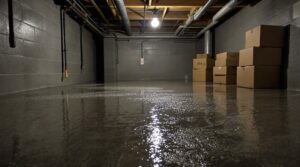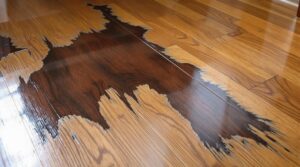Insurance payouts for water damage in 2025 vary considerably based on the source and coverage type. Standard claims for burst pipes average between $1,322 and $5,954, while plumbing issues typically settle around $11,605. Flood-related claims through NFIP average $44,401, though these require separate coverage. Regional factors impact settlement amounts, with coastal states showing higher averages. Understanding policy details and documentation requirements can greatly influence final payout amounts.
Key Takeaways
- Burst pipe incidents typically result in insurance payouts ranging from $1,322 to $5,954, depending on damage severity and location.
- Standard plumbing-related water damage claims average $11,605, specifically for sudden and accidental incidents.
- National Flood Insurance Program (NFIP) claims average $44,401 for flood-related damage requiring separate coverage.
- Southern states experience higher claim payouts, with premiums exceeding $2,000 due to increased hurricane risk exposure.
- Northeast region leads with high average payouts of $11,605, while California tops total losses at $15.5 billion.
Understanding Water Damage Insurance Coverage
Water damage insurance coverage encompasses a detailed array of protections and exclusions within standard homeowners insurance policies. Insurance providers typically cover sudden or accidental discharge from burst pipes, appliance failures, and overflow incidents from clogged fixtures.
Storm-related damage is also included, though flooding requires separate coverage. Understanding coverage limitations is essential for effective water damage prevention and streamlining the insurance claim process.
While manmade incidents like pipe bursts are generally covered, natural causes such as groundwater seepage and surface water damage are excluded. Policy coverage varies based on the source of damage, with sudden and accidental incidents receiving more favorable consideration than gradual deterioration or maintenance-related issues.
Homeowners can enhance their protection through optional endorsements, including water backup coverage and special personal property provisions. However, standard policies exclude flood damage, necessitating separate flood insurance for thorough protection against water-related perils.
Standard Insurance Payout Ranges for 2025
![Average Insurance Payout For Water Damage [2025] 1 Insurance Payouts For 2025](https://publicclaimsadjusters.io/wp-content/uploads/2025/02/insurance_payouts_for_2025.jpg)
Insurance payout ranges for water damage in 2025 reflect significant variations based on multiple determinants, including property location, damage severity, and specific policy terms.
Standard payout ranges are primarily influenced by the extent of damage and coverage limitations outlined in individual policies.
Insurance companies calculate payouts by evaluating documented damage severity, considering factors such as affected square footage, structural impact, and necessary restoration costs.
Policy adjustments account for depreciation, deductibles, and specific coverage caps that may limit maximum compensation.
Claims supported by thorough documentation and timely reporting typically result in higher settlements within the standard payout ranges.
The assessment process involves detailed evaluation by insurance adjusters, who determine compensation based on current repair costs and policy-specific limitations.
Professional documentation, including extensive damage reports and contractor estimates, plays a vital role in securing appropriate payouts within established coverage parameters.
Types of Water Damage and Their Typical Payouts
![Average Insurance Payout For Water Damage [2025] 2 Water Damage Types Payouts](https://publicclaimsadjusters.io/wp-content/uploads/2025/02/water_damage_types_payouts.jpg)
While homeowners face various types of water-related incidents, standard insurance policies differentiate between covered and non-covered events, with distinct payout ranges for each category. Insurance assessments typically approve claims for sudden and accidental water damage, with burst pipes averaging between $1,322 and $5,954 in compensation, while plumbing issues and appliance malfunctions see average payouts of $11,605.
| Type of Damage | Coverage Status | Average Payout |
|---|---|---|
| Burst Pipes | Covered | $1,322-$5,954 |
| Plumbing Issues | Covered if Sudden | $11,605 |
| Weather Floods | Not Covered* | $44,401 |
*Requires separate flood insurance through NFIP
Notably, standard policies exclude gradual water damage from ongoing maintenance issues and natural flooding events. For flood-related claims, homeowners with separate National Flood Insurance Program coverage receive substantially higher payouts, with the average claim reaching $44,401 in 2021. Documentation and prompt reporting remain vital factors in securing appropriate compensation for covered incidents.
Factors That Impact Your Insurance Settlement
![Average Insurance Payout For Water Damage [2025] 3 Insurance Settlement Influencing Factors](https://publicclaimsadjusters.io/wp-content/uploads/2025/02/insurance_settlement_influencing_factors.jpg)
Several key factors determine the final settlement amount when property owners file water damage claims with their insurers. The source and type of water damage greatly influence coverage, with clean water incidents typically receiving higher payouts than contaminated water damage.
Insurance companies carefully evaluate whether the damage resulted from sudden accidents or gradual deterioration, often excluding the latter from coverage.
Proper insurance claim documentation plays an essential role in settlement outcomes. Detailed records, including photographs, videos, and thorough descriptions of damages, strengthen the claim’s validity.
Additionally, demonstrating consistent water damage prevention through maintenance records can positively impact coverage decisions. The timing of claim reporting and implementation of mitigation measures also affects settlement amounts.
Policy terms and exclusions fundamentally shape potential payouts, with standard policies typically excluding flood damage and requiring separate coverage through programs like NFIP.
Professional assessments from adjusters and multiple contractor estimates can further influence the final settlement determination.
Filing a Successful Water Damage Claim
![Average Insurance Payout For Water Damage [2025] 4 Successful Water Damage Claim](https://publicclaimsadjusters.io/wp-content/uploads/2025/02/successful_water_damage_claim.jpg)
Successfully filing a water damage claim requires property owners to follow a systematic approach that maximizes their chances of receiving fair compensation. Insurance claim tips emphasize the importance of prompt documentation and professional communication with insurers. Property owners must immediately implement water damage prevention measures while gathering evidence for their claim.
| Action Step | Key Requirements |
|---|---|
| Initial Response | Stop water source, document damage with photos |
| Documentation | Create detailed inventory of damaged items |
| Professional Assessment | Obtain licensed contractor estimates |
| Claim Filing | Submit within policy timeframe, include all evidence |
| Follow-up | Track claim status, maintain communication records |
The claim process demands meticulous record-keeping of all damaged items, repair estimates, and correspondence with insurance representatives. Property owners should maintain copies of all submitted documentation and professional assessments. Understanding policy coverage limitations and deadlines is vital for maneuvering the claims process effectively, while regular follow-up guarantees the claim remains active and progresses toward resolution.
Common Coverage Exclusions and Limitations
![Average Insurance Payout For Water Damage [2025] 5 Insurance Policy Restrictions Outlined](https://publicclaimsadjusters.io/wp-content/uploads/2025/02/insurance_policy_restrictions_outlined.jpg)
Understanding the fine print of insurance policies reveals significant gaps in water damage coverage that can affect potential payouts.
Standard homeowners policies typically exclude damage from flooding, gradual leaks, and sump pump failures, while only covering sudden and accidental water events like burst pipes.
Policy holders must carefully review their coverage limitations and consider additional riders or specialized policies to protect against excluded water damage scenarios.
Understanding Policy Fine Print
When reviewing homeowners insurance policies for water damage coverage, careful attention to exclusions and limitations is essential, as insurance companies often include specific restrictions that can greatly impact claim payouts.
Standard policy exclusions typically encompass flood damage, negligence, and gradual deterioration, while claim limitations may apply to roof leaks and appliance failures.
Insurance policies frequently contain ambiguous wording in their exclusion clauses, which can limit coverage for water-related claims. Named perils must be explicitly listed for coverage to apply, and maintenance-related issues are generally excluded.
Understanding these fine print details is significant, as they determine whether incidents like sewer backups or mold growth require additional endorsements. Regular inspection and maintenance documentation can help prevent claim denials based on negligence exclusions.
Gaps in Coverage Protection
Many homeowners are surprised to discover significant gaps in their water damage coverage, with standard insurance policies excluding numerous common scenarios that can lead to costly repairs. Water damage prevention becomes vital when considering these exclusions, particularly since common coverage misconceptions can result in unexpected financial burdens.
| Excluded Events | Coverage Options |
|---|---|
| Flood Damage | NFIP or Private Flood Insurance |
| Groundwater Seepage | Additional Foundation Coverage |
| Sewage Backup | Specific Endorsements |
| Poor Maintenance | Regular Inspections & Repairs |
Standard policies typically exclude flooding from natural sources, groundwater infiltration, and sewage backups. Policy limitations also extend to damage caused by poor maintenance or neglected repairs. With approximately 14,000 Americans experiencing water damage daily and average payouts reaching $11,605, understanding these coverage gaps is essential for thorough protection.
Additional Coverage Options and Endorsements
![Average Insurance Payout For Water Damage [2025] 6 Expanded Insurance Policy Features](https://publicclaimsadjusters.io/wp-content/uploads/2025/02/expanded_insurance_policy_features.jpg)
Several essential endorsements and coverage options exist beyond standard homeowners insurance to protect against various types of water damage.
Water backup coverage, typically costing between $50 and $250 annually, provides protection against damage from clogged sewer lines, failed sump pumps, and backed-up drains, including resultant mold damage. Coverage limits range from $5,000 to full replacement cost.
Sump pump failure coverage is particularly vital for homes dependent on these systems, as standard policies exclude such damage without specific endorsements.
Additional options include flood insurance through the National Flood Insurance Program, with average claims reaching $42,580 in 2018.
Dwelling replacement coverage can provide up to 30% above policy limits, while scheduled items coverage protects specific valuables.
When selecting coverage, homeowners must consider policy limitations, damage causes, and payout calculations that factor in repair costs, materials, labor, depreciation, and deductibles.
Regional Differences in Water Damage Payouts
![Average Insurance Payout For Water Damage [2025] 7 Water Damage Payout Variations](https://publicclaimsadjusters.io/wp-content/uploads/2025/02/water_damage_payout_variations.jpg)
Insurance payouts for water damage vary considerably across different regions of the United States, reflecting diverse geographic risks and climate patterns.
California leads with $15.5 billion in total homeowners insurance losses, followed by Florida at $8.3 billion and Texas at $6.9 billion, demonstrating significant regional climate impacts on claim volumes.
The Northeast, particularly New York, experiences high average payouts, with claims reaching $11,605.
Southern states face substantial costs due to hurricane exposure, with Florida, Texas, and Louisiana showing elevated premium rates exceeding $2,000.
Urban density effects are evident in metropolitan areas, where property values drive higher claim amounts.
The Midwest reports moderate payouts, with Illinois leading at $2.8 billion in total losses despite lower average premiums around $1,000.
Western states show varying patterns, influenced by distinct environmental risks such as wildfires and coastal flooding, affecting both claim frequency and payout amounts.
The Benefits Of Consulting A Public Adjuster
![Average Insurance Payout For Water Damage [2025] 8 Expert Assistance For Claims](https://publicclaimsadjusters.io/wp-content/uploads/2025/02/expert_assistance_for_claims-57.jpg)
Public adjusters provide expert guidance throughout the insurance claims process by leveraging their specialized knowledge of policy terms and procedures.
Their objective assessment of water damage helps identify all covered losses while ensuring proper documentation and compliance with policy requirements.
Through skilled negotiation with insurance companies and efficient management of claim complexities, public adjusters often secure higher settlements while reducing the burden on policyholders.
Expertise In Insurance Claims
When dealing with complex water damage claims, consulting a public adjuster can considerably improve the chances of receiving fair compensation from insurance companies.
Public adjuster roles encompass extensive policy analysis, thorough damage documentation, and expert claims preparation, ensuring all aspects of water damage are properly assessed and documented.
These professionals excel in claims negotiation strategies, leveraging their specialized knowledge of insurance policies and regulatory requirements to advocate effectively for policyholders.
Their expertise includes interpreting complex policy terms, understanding coverage limitations, and identifying opportunities for maximum compensation.
Working on a contingency basis, public adjusters align their interests with the policyholder’s goals, utilizing their experience to navigate intricate claims processes and negotiate with insurance companies for ideal settlements.
Objective Damage Assessment
Obtaining an objective assessment of water damage requires specialized expertise and advanced diagnostic tools to uncover both visible and concealed issues. Professional assessors utilize moisture meters and thermal imaging technology to detect hidden damage that might otherwise go unnoticed during claim documentation.
| Assessment Component | Key Benefits |
|---|---|
| Moisture Detection | Prevents mold growth and structural deterioration |
| Thermal Imaging | Identifies water intrusion in walls and ceilings |
| Documentation Tools | Creates detailed evidence for insurance claims |
A thorough evaluation guarantees all damage aspects are properly documented and valued for insurance purposes. This systematic approach helps prevent undercompensation and facilitates smoother claim resolution. Professional assessors also identify potential secondary effects that could develop over time, strengthening the policyholder’s position during negotiations with insurance companies.
Streamlined Claim Process
Engaging a public adjuster greatly streamlines the insurance claims process for water damage cases.
These professionals handle all aspects of communication with insurance companies, managing paperwork and documentation requirements with precision and expertise.
The claim efficiency is notably enhanced as public adjusters guarantee timely filing while maintaining accurate records throughout the process.
Their systematic approach includes thorough damage assessments, proper documentation submission, and strategic negotiation with insurers.
Through effective paperwork management, they eliminate common filing errors that could delay settlement.
Public adjusters also provide regular updates on claim status, reducing policyholder stress and uncertainty.
Their professional representation guarantees claims move forward efficiently, allowing property owners to focus on recovery while maintaining confidence that their interests are being protected throughout the settlement process.
Higher Claim Payouts & Settlements
Public adjusters considerably increase the likelihood of higher insurance payouts for water damage claims through their expertise in thorough damage assessment and skilled negotiation tactics.
Their claim strategies include extensive damage identification using advanced tools like moisture meters and thermal imaging to detect hidden water damage that might otherwise go unnoticed.
During settlement negotiation, public adjusters leverage their in-depth understanding of insurance policies to maximize benefits for policyholders.
Their expertise in accurately quantifying damages and presenting claims clearly often results in substantially higher settlements compared to what policyholders might secure independently.
About The Public Claims Adjusters Network (PCAN)
![Average Insurance Payout For Water Damage [2025] 9 Public Claims Adjusters Network](https://publicclaimsadjusters.io/wp-content/uploads/2025/02/public_claims_adjusters_network-143.jpg)
The Public Claims Adjusters Network (PCAN) stands as a specialized organization connecting licensed insurance claim professionals who advocate exclusively for policyholders during property damage claims. These experts leverage extensive knowledge of insurance policies and industry practices to maximize settlements while ensuring regulatory compliance throughout the claims process.
| Service Component | Public Adjuster Benefits |
|---|---|
| Initial Assessment | Expert damage evaluation & documentation |
| Claims Management | Complete handling of paperwork & processes |
| Negotiation Strategy | Professional representation with insurers |
| Settlement Optimization | Maximum potential payout outcomes |
PCAN members provide essential Claims Process Insights through their thorough understanding of policy complexities and insurance industry practices. Their expertise proves particularly valuable in water damage cases, where proper documentation and timely action greatly impact claim outcomes. By managing all aspects of the claims process, these professionals enable property owners to focus on recovery while ensuring their interests are professionally represented.
Frequently Asked Questions
Does Filing a Water Damage Claim Increase My Future Insurance Premiums?
Filing a water damage claim typically results in premium increases ranging from 10-50%, with the claim impact varying based on damage severity, frequency, and the insurer’s risk assessment.
How Long Do I Have to File a Water Damage Claim?
Insurance policies generally require water damage claims to be filed within 48 hours of discovery, though specific timelines vary by insurer. Florida law allows up to one year for property damage claims.
Can I Switch Insurance Companies While a Water Damage Claim Is Pending?
Policyholders can legally execute an insurance policy transfer while a water damage claim is pending, though this may introduce claim process implications including potential delays and additional documentation requirements.
Are Temporary Relocation Costs Covered During Water Damage Repairs?
Homeowner’s insurance typically covers temporary housing and relocation expenses during water damage repairs if the home is deemed uninhabitable. Coverage depends on policy terms and requires documentation of necessary living expenses.
Will Insurance Cover Water Damage Repairs Done by Unlicensed Contractors?
Insurance policies typically exclude coverage for repairs performed by unlicensed contractors. Licensed contractor requirements exist specifically to protect homeowners, as unauthorized work can void insurance coverage and create significant liability exposure.








